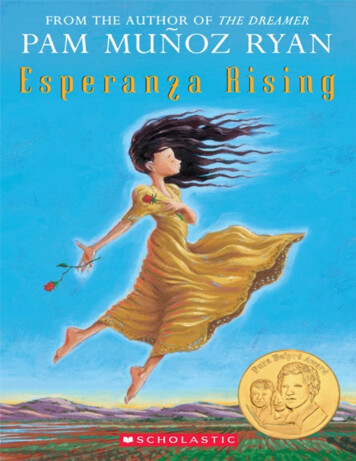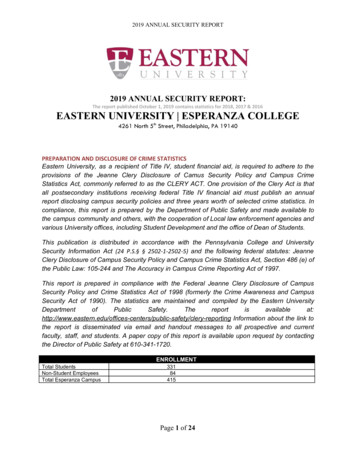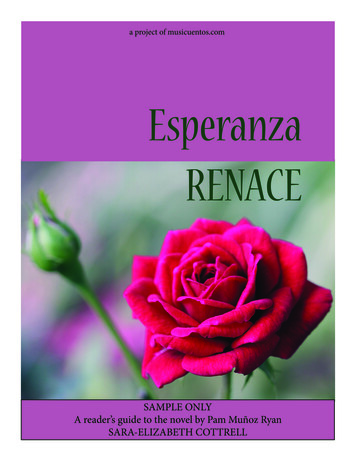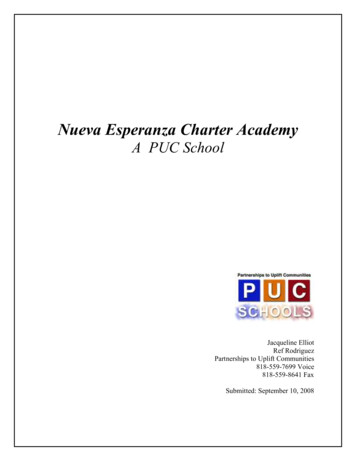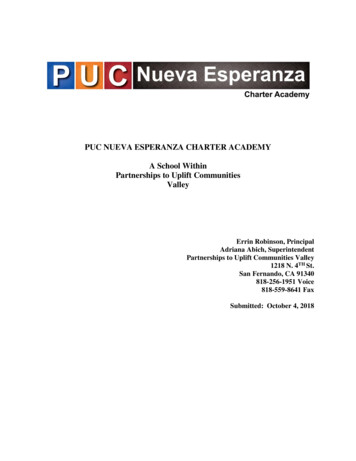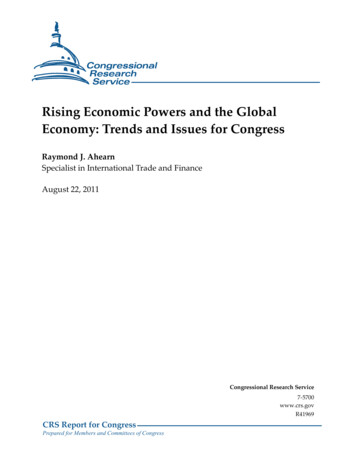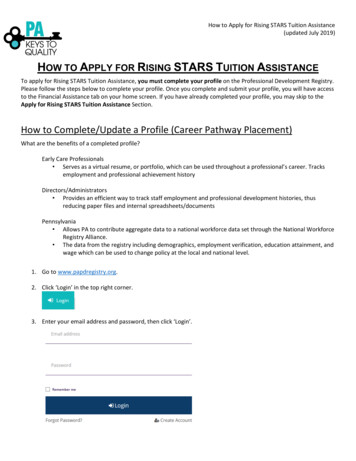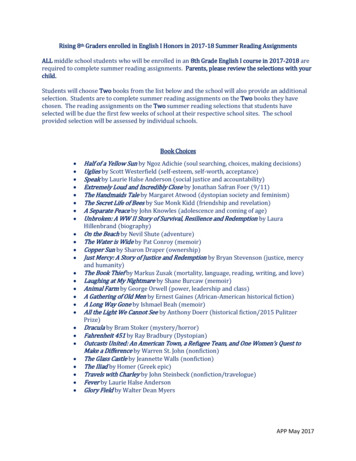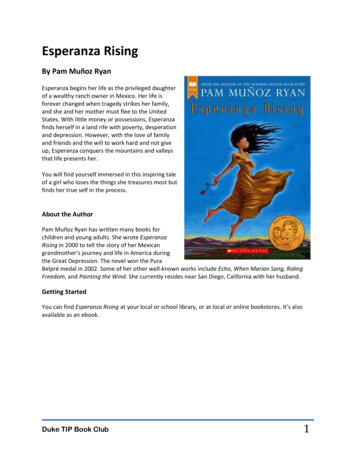
Transcription
Esperanza RisingBy Pam Muñoz RyanEsperanza begins her life as the privileged daughterof a wealthy ranch owner in Mexico. Her life isforever changed when tragedy strikes her family,and she and her mother must flee to the UnitedStates. With little money or possessions, Esperanzafinds herself in a land rife with poverty, desperationand depression. However, with the love of familyand friends and the will to work hard and not giveup, Esperanza conquers the mountains and valleysthat life presents her.You will find yourself immersed in this inspiring taleof a girl who loses the things she treasures most butfinds her true self in the process.About the AuthorPam Muñoz Ryan has written many books forchildren and young adults. She wrote EsperanzaRising in 2000 to tell the story of her Mexicangrandmother’s journey and life in America duringthe Great Depression. The novel won the PuraBelpré medal in 2002. Some of her other well-known works include Echo, When Marian Sang, RidingFreedom, and Painting the Wind. She currently resides near San Diego, California with her husband.Getting StartedYou can find Esperanza Rising at your local or school library, or at local or online bookstores. It’s alsoavailable as an ebook.Duke TIP Book Club1
While You’re ReadingEvery good story is full of captivating characters, timeless and timely themes, significant settings, pivotalplot points, and vivid vocabulary that combine to engage our brains and our hearts. In this section of thewebsite, you will find activities that invite you to dig deeper into each of these literary elements for abetter understanding and enjoyment of the book.To aid your investigation, save our “Writing While You Read” guide (see pages 19 and 20), with helpfultips on keeping a reading journal and annotating a book while you read.Respond to the following prompts in your reading journal as you read (or re-read!) Part 1 of EsperanzaRising: The key way a writerhelps his or her readersconnect with a story isthrough its characters.Which qualities,behaviors, and choicesdo you think makesome characters moreappealing than others?To help you answer thisquestion with specificevidence from thebook, use theCharacter Grid you’llfind on pages 21 and22 below (and you canmake extra copies ofpage 22 if you needthem). Tuck it insideyour book, and, eachtime you meet a new character, take a minute to jot down the name and your initial observationsabout him or her on your Character Grid. Be sure to revisit your Grid every few chapters or so, too!There may be more ideas you want to add as you get to know each character better. At the beginning of the book, six-year-old Esperanza is among the grape vines with her father. Hetells her that the earth is alive and that you can hear its heartbeat if you listen closely. Esperanza isunable to hear the beating beneath the earth and her father tells her: “Wait a little while and thefruit will fall into your hand. You must be patient, Esperanza” (2).o Why do you think Esperanza’s father wants her to listen for the heartbeat of the earth?o What does Esperanza’s father mean by “the fruit will fall into her hand?”o Why is patience so important? Give examples of how patience is shown in the book.Duke TIP Book Club2
The author of Esperanza Rising, Pam Muñoz Ryan, organizes the book into chapters that are titleswith the name of the produce that is harvested during that time of the year.o Why do you think she chose to structure the book this way? What do the titles help youunderstand as a reader?o Why do you think she wrote the chapter titles in Spanish and then translated into English insmall print below? The author describes the crowd of workers who have gathered for the grape harvest at El Ranchode la Rosas: “They were covered top to bottom in long sleeved shirts, baggy pants. and bandanaswrapped around their foreheads and necks to protect them from the sun, dust and spiders.Esperanza, on the other hand, wore a light silk dress that stopped above her summer boots, and nohat” (5).o What does the author want you to understand when she contrasts the way Esperanza isdressed and the way the Vaqueros are dressed?o How is Esperanza’s life different from the life of the workers on the ranch? “Papá had promised to meet her in the garden and he never disappointed her . Darkness wouldsettle quickly and a feeling of uneasiness and worry nagged at her. Where was Papá?” (8-9).This is an example of foreshadowing in the story. Authors often use foreshadowing to give thereader clues about what will happen later in the story.o Why do you think that the author uses foreshadowing at this point in the story?o What clues is the author giving you about what might happen later in the story?o How does this quote build suspense and make you want to continue reading? In the story, Esperanza says she understands that “Miguel [is] the housekeeper’s son and she [is]the ranch owner’s daughter and between them [runs] a deep river” (18).o What do you think the “river” represents to Esperanza in the story?o Later when Miguel talks of going to the United States he says, “You were right, Esperanza. InMéxico we stand on different sides of the river” (37). Does Miguel think it will be different inthe U.S.? Why or why not? Pam Muñoz Ryan describes Tío Luis and Tío Marco as “la calabaza, the squash plant in Alfonso’sgarden, whose giant leaves spread out, encroaching upon anything smaller” (28-29).o What do you think the author means by this?o Give examples of what the uncles do to “encroach” upon Esperanza and her family.Duke TIP Book Club3
As Esperanza struggles to sweep the wooden platform at the camp, “A group of women [are]laughing at her. And in the middle of the group [is] Marta, pointing. ‘La Cenicienta! Cinderella!’ Shelaugh[s]. Burning with humiliation, Esperanza drop[s] the broom and [runs] back to the cabin”(112).o Why does Marta treat Esperanza in such a cruel way?o How is Esperanza like Cinderella from the fairy tale?o Why is Esperanza embarrassed by Marta and the other women laughing at her?Respond to the following prompts in your reading journal as you read (or re-read!) Part 2 of EsperanzaRising: Esperanza compares her mother’s illness to a valley, wondering, “[Will] she ever escape this valleyshe [is] living in? This valley of Mamá being sick?”(160).How is Esperanza’s life in the United States like mountains and valleys? Give specific examples(other than Mama’s illness) of the ups and downs Esperanza experiences. Compare and contrast Esperanza’s character with Marta’s character. Draw a Venn diagram (seepages 23 and 24 below) in your journal to help you describe the similarities and differencesbetween these two characters. As the family discusses the farm worker strike, Miguel tells his father that more and more peopleare coming to the area. “Some of them say they will pick cotton for five and six cents a pound, andwill pick produce for less. People cannot survive on such low wages” (203).o Why are people willing to come and work for less than what other people are making?o What does the father think about these people? Should he be worried about their presence?Why or Why not? At the end of the strike, immigration officials take many of the strikers away from the farms todeport them back to Mexico. However, Marta manages to evade the officials and hide. Despitetheir history, Esperanza brings Marta an apron and helps her disguise herself as a worker (209).o Why is Esperanza willing to help Marta?o What do Esperanza’s actions tell us about her as a character?o Would you have helped Marta if you were in Esperanza’s position? Why or why not? The day after Esperanza helps Marta, she visits the strikers’ farm. The land has been abandonedbut the piñata she had given the children is still hanging from a tree, “its tissue streamers flutteringin the breeze. It had been beaten with a stick, its insides torn out” (213).o Why do you think the author includes this image of the piñata?o What does the piñata represent or symbolize in the story?Duke TIP Book Club4
When Isabel does not win the Queen of May because she isn’t white, Esperanza consoles her bysaying: “Isabel, it does not matter who won. Yes you would have made a beautiful queen, but thatwould have lasted for only one day. Aday goes by fast, Isabel. And then it isover” (227).o What does Esperanza want Isabel tolearn from this experience?o Why is it so special that Esperanzagives Isabel her doll? At the beginning of Esperanza’s journeyto the United States, she has a difficulttime letting go of the privilege she hadin Mexico. However, over time shebecomes less selfish and beginssacrificing her happiness and providingcomfort for her family and friends.Give at least three examples from thestory that show how Esperanza haschanged. Explain your thinking.Duke TIP Book Club5
Getting to the RootEnglish is a living language. Itchanges and grows all the time. Oneof the best ways to understand thehistory of the English language andto unlock the meanings of unfamiliarwords is to learn Latin and Greekword parts. As you study biology, youwill learn more and more of theseword parts, and once you knowthem, you will begin to recognizethem in all kinds of words—andyou'll find that your knowledge ofthose word parts will help youdecipher the meanings of unfamiliarwords.Roots are the "base" of plants, and Latin and Greek roots form the base of many English words. Forexample, the Latin root audi means “to hear.” How many modern English words can you think of thatinclude the root audi?Next, take a look at each word part below. Beside each part is a word from Esperanza Rising containingthat word part. You can find the word in context on the page number in parentheses. soph – philosophical (13)dol – condolences (26)du – duplicates (49)spir – perspiration (88)vari – various (121)sep - antiseptic (231)Can you determine the meaning of the root from your knowledge of the word beside it?If not, think of other words that you know that also contain that root. What do those words have incommon? Based on that common element, can you figure out the meaning of the root?3. If you're still stumped, check out this list of Latin and Greek roots.4. Now that you know the meaning of the root, how many words can you generate that use the root?5. Once you understand the meaning of the root, you'll find that even your understanding andappreciation of familiar words will deepen and grow when you think about how that root works inthose words.1.2.Duke TIP Book Club6
Words, Words, WordsEsperanza Rising is full of great words. Below is a list of some of the words from the book that may beunfamiliar to you, along with the page number on which each word appears in the story. Be sure tofollow the steps below for other words in the book that are new to you. scythe (4)premonition (9)indignation (30)correspondence (51)valise (69)hillock (95)anticipating (104)suede (152)spores (155)listless (161)grotto (164, 214)repatriation (170)anguish (208)irrigation (220)cacophony (250)Before you look these words up in a dictionary—or ask someone what they mean—try working throughthe following steps:1. Generate a list of other words that share one or more of the same word parts. What do the wordson the list have in common? Are there any clues from those commonalities that you can use to helpfigure out the meaning of the unknown word? Hint: Some word parts—as they appear in Englishwords—have multiple meanings as we look back at the Latin and Greek, in part because of changesthat have occurred in the words over the years. For example, does the "ped-" in "pedestrian" meanthe same thing as the "ped" in "pediatrician"? Where there is possible confusion, or when youdon’t see familiar word parts, context clues (see step 2) are extremely important.2. Go back and reread the word in its context. This context includes the sentence in which you findthe word, but you should also read one or two sentences both before and after the appearance ofthe word. What context clues do you find that might unlock the meaning of the word for you?3. Make your best guess at the meaning of the word.4. Look up the definition in a dictionary. Be sure to also look for information about the word's origin.This information will often contain the Latin or Greek word from which the word is derived.5. How close was your guess?Duke TIP Book Club7
ExploreOur world is full of connections—between people, places, and events. In this section of the website, youwill find activities that uncover some important connections—in history, meteorology, climate science,epidemiology, and mythology — between Esperanza Rising and our world.The Immigrant Experience During the Great DepressionEsperanza comes to the United States during one of the most dire times in our history. The GreatDepression was caused by a collapse of the financial system and weather that particularly devastatedagricultural industries throughout the country. Life was extraordinarily difficult for most people in thecountry. However, many Mexican Americans and other people of color were treated even worse duringthe Depression. The strikes and stories of racism presented in the novel were all inspired by true eventsthat happened during the 1930s in the Central Valley of California.Explore the resources below to better understand the important events that were occurring during thesame time period of the book. Learn about the history of The GreatDepression on this webpage that includesfacts, a quiz, a crossword puzzle, and a wordsearch. Examine an article and images of Mexicanimmigrant workers during the Greatdepression. Watch a short video to learn more about theprocess of repatriation of Mexican Americansduring the 1930s. Discover why and how many U.S. Citizenswere unlawfully deported during the 1930s inthis article about Mexican repatriation. Listen to an interview with author, historian,and professor Francisco Balderrama about thehistory of Mexican Repatriation in the UnitedStates.Reflection Questions Why is repatriation considered to be contrary to American ideals? Why do you think it was important for Pam Muñoz Ryan to tell the story of Esperanza?Duke TIP Book Club8
If you read one of our earlier book-club selections, Hidden Figures, what connections can youmake between the experiences of women in that book and the experiences of characters inEsperanza Rising?The Storms that Cause the FeverIn the novel, a dust storm hitsthe farm where Esperanza andher mother live. Esperanzawatches as the stormapproaches: “Thousands ofacres of tilled soil [are]becoming food for la tormentaand the sky [is] turning into abrown swirling fog” (148). Thestorm doesn’t only bring dustand dirt, but it also bringssickness. Esperanza’s motherquickly becomes very ill withValley Fever. Check out theresources below to learn moreabout how dust storms form and how these storms cause people to be infected with Valley Fever. Watch this video to learn about the basics of Valley Fever. Discover the history of Valley Fever in this article from the California county in whichEsperanza's story was set. Learn the answers to basic questions about Sandstorms (Dust storms). Get a sense of how a dust storm forms in this video from the weather channel. Find out why more dust storms have been occurring in the Southwest over the last few years. Explore the connections between climate change and Valley Fever in the present-day UnitedStates.Reflection Questions Based on what you have learned about Valley Fever, why do you think Esperanza’s mother wasinfected with Valley Fever and Esperanza was not? Why have the number of cases of Valley Fever risen in the last few years?Duke TIP Book Club9
Dig Up Information on Farming in CaliforniaThe fertile soil of central California provides the setting for Esperanza’s story. Without farming and theagriculture industry, many people would not have migrated to this area. Discover more about farmingin California with the resources below. Read a short passage and test your knowledge about the history of farming in California. Check out this harvest calendar to discover when crops grow and are harvested in California. Discover what farming was like during The Great Depression in this short video. Learn about the current agriculture industry of the Central Valley of California (where themajority of the story took place) and how it provides the majority of produce that America eats. Explore this interactive map of California agriculture in 1920. (You need Flash for this website.Make sure to click the arrows so that the symbols show up on the map.)Reflection Questions Using the harvest calendar above, in what month would each chapter have occurred in thenovel? How is the Central Valley of California important to America and how we eat? What would be the potential consequences if the Central Valley again began to experience duststorms like those in the book?Duke TIP Book Club10
Rising from the AshesSymbolism is a type of figurative language that authors use to help the reader find more meaning andfeeling in their writing. The mythical figure of the phoenix is a symbol of rebirth that is often seen inliterature and popular culture. In Esperanza Rising, Abuelita says “We are like the phoenix Rising again,with a new life ahead of us” (50). Let’s find out more about this amazing symbol! Watch a slideshow and read anarticle to learn facts about themythological symbol of thephoenix. Explore more about the phoenixthrough this article and set ofactivities. Discover the different variationsof the phoenix myth in thisarticle. Have fun creating the image of aphoenix with this online jigsawpuzzle. Read a version of The Story of thePhoenix.Reflection Questions In what ways is the character of Esperanza like the phoenix from the myths you haveresearched? Why do you think the image of the Phoenix is so often used in literature, movies, comics andother forms of popular culture? Where else in contemporary culture have you seen the Phoenix used as a symbol of rebirth?Duke TIP Book Club11
CreateAn important part of learning is having the chance to produce something of your own. Here you will findengaging projects that connect with the novel and that allow your creative abilities to shine.Map It!In order to escape her vengeful uncles, Esperanza and her mother travel from Mexico to the UnitedStates. Create a map that tracks her journey from the grapevines of Aguascalientes to the farms ofArvin, California.Follow these steps to create your map:1. Go to Google maps.2. Select the menu in the upper-left corner - the icon is three horizontal lines and it’s beside the“Search Google Maps” bar.3. Select “Your places” “MAPS.”4. Select “SEE ALL YOUR MAPS” this should open a new tab.5. Choose the menu in the upperleft corner - the icon is threehorizontal lines and it’s besidethe “GoogleMy Maps” heading.6. Choose “Create a New Map.”7. Give the map a title8. Mark the following places thatEsperanza and her motherwent through on their way toArvin: AguascalientesZacatecas (65)Mexicali (81)Los Angeles, CA (85)Highway 99 (93)Arvin, CA9. Print the map you have made.10. Add a key to mark the types of transportation (wagon, train, truck, etc ) they used on each partof the trip.11. Share your map with a family member or friend and explain the significance of each location inthe story.Duke TIP Book Club12
Sing Me a SongMexican Ballads called Corridos were sung often during the Great Depression. See an example of aCorrido’s lyrics from the Great Depression here.Create the lyrics to your ownsong or Corrido that tellsEsperanza’s story. Be sure toinclude the following: the title of your song;at least 10 lines (you canrepeat a chorus) that tell astory;lyrics that reflect the moodand feeling that Esperanzahad during the novel;symbols or imagery fromthe book; andlyrics that have rhythm andrhyme (optional).You can share just your lyrics,or you can put your song tomusic and perform it for familyand friends.Book ReviewOthers’ opinions of books can often help us decide if we want to read a particular text. A book review isone way for readers to share their thoughts about a book they’ve read.Your task is to create a book review of Esperanza Rising that encourages others to read the book. Yourreview could be a video, slide show, or a poster advertisement. Make sure to include the following: the book’s title and author, and an image of the book for your audience;an explanation of what type(s) of reader will enjoy your book;a short summary of the book (Do NOT give away the ending, but entice a reader to pick your bookup!);three key elements that make this book really stand out;information about your favorite scene: Select a tiny excerpt of the book that reveals something enticing about your book. State the page number where a reader would find the excerpt.Duke TIP Book Club13
If you’re creating a video, use a good read-aloud voice.Wrap up your review by telling what you think the author’s message is to readers of the book.Your product should show evidence of accuracy, as well as thoughtful work that will make others want toread the book. Sell the book! If you enjoy this activity, ask a parent or other trusted adult to help you goto a site like DOGObooks and post your review. You could also create reviews for other books you haveread.Duke TIP Book Club14
Reflect & Connect PromptsIn Duke TIP’s online Book Club, the “Reflect & Connect” prompts provide an opportunity for students toshare their ideas about the book with other Duke TIP students. You may choose to record yourresponses to these questions in your Reading Journal, or you can use them to talk about the book withfriends or classmates who have also read it.Complex AbuelitaEsperanza describes her grandmother as someone who “might host a group of ladies for a formal tea inthe afternoon, then after they had gone, be found wandering barefoot in the grapes, with a book in herhand, quoting poetry to the birds” (13). What do you learn about the character of Abuelita from this description?The strong contrast in Abuelita's behavior shows that she is a complex and rich character. Thinkabout someone in your family that you are close to. How might you see a similarly strongcontrast in their behaviors?Different PerspectivesWhen Esperanza refuses to let the little girl on the train play with her doll, Mamá scolds Esperanzasaying, “When you scorn these people, you scorn Miguel, Hortnesia, and Alfonso. And you embarrassme and yourself. As difficult as it is to accept, our lives are different now” (70). What does the doll mean to Esperanza? Why does she value it so much?Why do you think Esperanza is so reluctant to let the girl play with her doll?Do you think that Esperanza’s mom is right to scold her? Why or why not?What does Mamá want Esperanza to understand about their new life?Reading RainbowOn the way to the farm camp in Arvin, Isabella shares with Esperanza what she knows about their newhome. She explains that it is much bigger than the tent camp they lived in previously; it has electricityand running water, among other things. However these are not the aspects she is most excitedabout. “Isabella lean[s] toward Esperanza and grin[s] as if she were telling her a big secret. ‘And aschool. Next week, I get to go to school, and I will learn to read’” (89). Why is Isabella so excited about learning English and how to read?How would your life be different if you didn’t have these skills at age 8?The Plight of a CatThe night of the jamaica, the party at the farm camp, Esperanza witnesses Marta and a man arguingabout whether the workers should strike. Marta compares the workers to a small kitten, “This is whatwe are! Small, meek animals. And that is how they treat us because we don’t speak up.” A man in thecrowd responds, “Maybe all that cat wants to do is feed his family. Maybe it doesn’t care what all theDuke TIP Book Club15
other cats are doing” (132). Marta and the man represent the different sides of the argument betweenthe workers. One side wants a better life for themselves and others in their community. The other sidejust wants to survive and take care of their families. Which side do you agree with? Explain your thinking.Do you agree with Esperanza’s decision not to strike? Why or why not?If you lived during this time period, what would you do in Esperanza’s situation?Injustice of RacismEsperanza becomes increasingly infuriated by the racism that she and other people of color experiencein the camps. She finally explodes, telling Miguel: “Is this the better life that you left Mexico for? Is it?Nothing is right here! They send people back to Mexico even if they don’t belong there, just forspeaking up. We live in a horse stall. And none of this bothers you?” (221). How would you feel if you were treated unfairly and unjustly, based only on the color of yourskin?What are other examples in the text of ways that Mexican Americans were victims of prejudiceor racism?We know that Esperanza’s life is much harder in the United States, but how has Miguel’s lifechanged? Do you think it is harder or easier? Give examples from the text to support yourthinking.Miguel’s Secret MissionThe choices characters make tell us a lot about who they are. After Miguel and Esperanza fight, hedisappears from the camp with all of the money that Esperanza had saved. When he returns, he bringsher Abuelita with him. “He [says] that Ramona and Esperanza [need] her” (246). He risks everything tobring Esperanza what she truly needs. Do you agree with Miguel’s choice to go on a mission to bring Abuelita to the United States?Why or why not?Why does Miguel leave and take the money without telling anyone?Why do you think he didn’t at least leave a note?What would you have done in this situation?Duke TIP Book Club16
The Courage to Start OverThroughout the story, Esperanza struggles to finish crocheting the blanket Abuelita started with her.Before Esperanza leaves Mexico, Abuelita unravels Esperanza’s rows of yarn and says, “Do not be afraidto start over” (15). The story ends with Esperanza saying the same thing to a frustrated Isabel:“Esperanza smile[s] and reache[s] over and gently pull[s] the yarn.she look[s] into Isabel’s trusting eyesand sa[ys], ‘Do not ever be afraid to start over’” (253). Why do you think the author repeats this phrase in the novel? What does she want the readerto understand?Give examples of times in your life when you have had to be willing to start over. What did youlearn from these experiences?The True Story of EsperanzaAt the end of the novel, Pam Muñoz Ryan includes an author’s note. This section details the story of hergrandmother, the real Esperanza, who had experiences similar to those of the character in the story.Ryan writes, “When I was a young girl, Grandma used to tell me what her life was like when she firstcame to the United States from Mexico” (255). Why do you think the author includes this note at the end of the novel?What parts of the novel were the same as Ryan’s grandmother’s real life and what parts weredifferent?In what ways did the author’s note change your perspective of Esperanza’s story?The last line of the author’s note reads, “It is no wonder that in Spanish, esperanza means‘hope’” (262). What are examples of the idea of hope in the novel?Duke TIP Book Club17
Keep ReadingA few thoughts on books and reading."When I have a little money, I buy books;and if I have any left, I buy food andclothes."—Erasmus"The more that you read, the more thingsyou will know. The more that you learn,the more places you'll go."—Dr. Seuss"Outside of a dog, a book is man's bestfriend. Inside of a dog it's too dark toread."—Groucho MarxWhat's next?We hope that you enjoyed reading Esperanza Rising, by Pam Muñoz Ryan. Check your email forinformation about our next book club selection. In the meantime, if you are looking for a new bestfriend—and aren't inside a dog—here are some books you might enjoy. Don't forget to use the tips from“Writing While You Read” (see pages 19 and 20) to deepen your enjoyment and understanding of thesebooks too. Mrs. Frisby and the Rats of NIMH, byRobert C. O’BrienRasco and the Rats of NIMH, by JaneLeslie ConlyAll Four Stars, by Tara DairmanThe Stars of Summer, by Tara Dairman(sequel to All Four Stars)The Tell-Tale Start and other books in“The Misadventures of Edgar & AllanPoe” series by Gordon McAlpineMasterminds, by Gordon KormanMy Near-Death Adventures, by AlisonDeCampThe Scavengers, by Michael PerryA Single Shard, by Linda Sue ParkThe Island of Dr. Libris, by ChrisGrabensteinEscape from Mr. Lemoncello’s Library,by Chris GrabensteinThe Lost Kingdom, by Matthew J. KirbyFlora & Ulysses: The IlluminatedAdventures, by Kate DiCamilloDuke TIP Book Club The House of Power, by Patrick CarmanRivers of Fire, by Patrick CarmanThe Dark Planet, by Patrick CarmanThe Phantom Tollbooth, by NortonJusterNavigating Early, by Clare VanderpoolThe Apothecary, by Maile MeloyThe Apprentices, by Maile Meloy(sequel to The Apothecary)The City of Ember, by Jeanne DuPrauThe People of Sparks, by Jeanne DuPrauThe Prophet of Yonwood, by JeanneDuPrauThe Diamond of Darkhold, by JeanneDuPrauThe Mysterious Benedict Society, byTrenton Lee StewartChasing Vermeer, by Blue BalliettThe Lightning Thief, by Rick RiordanFever 1793, by Laurie Halse AndersonThe Invention of Hugo Cabret, by BrianSelznick18
Duke TIP Book Club19
Duke TIP Book Club20
Duke TIP Book Club21
Duke TIP Book Club22
Duke TIP Book Club23
Duke TIP Book Club24
Duke TIP Book Club 7 Words, Words, Words Esperanza Rising is full of great words. Below is a list of some of the words from the book that may be unfamiliar to you, along with the page number on which each word appears in the story. Be sure to follow the steps below for other words in

